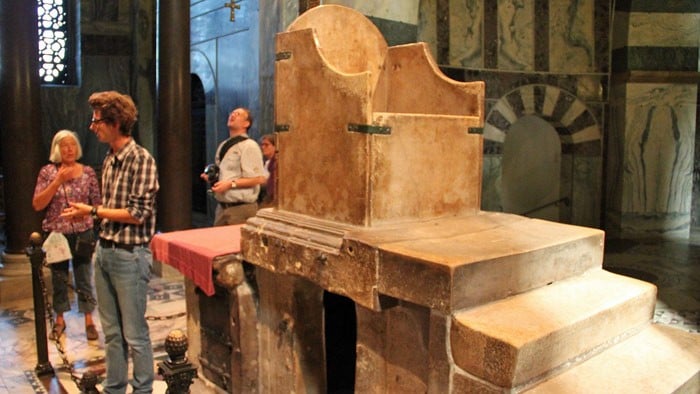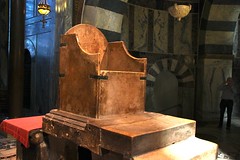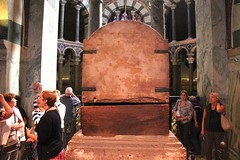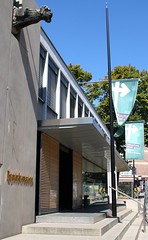The marble throne and shrine of Charlemagne in the Aachener Dom can only be seen when on a guided tour of the historic Aachen Cathedral.
The marble throne of Charlemagne (Karl der Grosse / Charles the Great), where 30 German kings were crowned, can be seen only on a guided tour of the Aachener Dom in Germany. Similarly, only visitors on the guided tour may enter the choir area of Aachen Cathedral for a close-up view of the gilded shrine of Charlemagne. The tour of the cathedral is well worth the small charge not only to see the throne but also for the wealth of information that the guides provide on Charlemagne and the cathedral.
The Throne of Charlemagne in Aachen Cathedral
The marble throne of Charlemagne is on the second level (Hochmünster) of the Imperial Cathedral (Kaiserdom) in Aachen. It was installed around 800 to the specifications set by Charlemagne himself and in contrast to most of the church has been virtually unaltered since. The throne is referred to mostly as either the Aachener Königsthron (Royal Aachen Throne, as German kings were crowned here) or the Karlsthron (Charles’ Throne, as it was made for Charlemagne).
Close up the throne of Charlemagne looks remarkably simple and unadorned by decorations but there is not a single aspect of this royal seat that is not of high symbolic significance. Almost all materials used in its construction were brought from specific sites for its symbolic, religious, or political connotations.
The main part of the throne is four white marble slabs – they are currently stained a yellowish-brown as the throne was covered in a tar substance during the Second World War that protected but discolored the marble. It would be possible to polish it back to white but that would also take care of the ancient markings on the marble slabs.
The four marble slabs forming the sides, front, and back of the throne are held together with bronze clasps. The fifth slab, which formed the base for the seat, has been lost while the original wooden framework used inside the seat is currently in the Rheinisches Landesmuseum in Bonn.
Ancient inscriptions on the marble slabs, including a board game and builders’ markings, confirm that the marble is second hand (and the latest research hints at third or fourth hand). On the back is also a very early drawing of the crucifixion of Christ.
However, this throne was not built on the cheap. Scientific research confirmed that the marble was floor stones brought from the Church of the Holy Sepulchre in Jerusalem. It was of course quite a long haul from the Holy City to Aachen, even with Charlemagne ruling most of Western Europe during the late 8th century. However, it was all about the symbolism – the chapel of Charlemagne was like the New Jerusalem and the imperial throne of Charlemagne the throne of the anointed one.
The marble of the lower section of the back has been cut and replaced by a wooden plank. This provided an opening where imperial insignia and other items could be placed. Symbolically the most important was the Purse of St Stephan (Stephansburse now in Vienna with the rest of the imperial insignia but a copy of this reliquary is in the local treasury). It was believed that this early 9th-century purse reliquary contained sand stained by the blood of St Stephan – the first Christian martyr. As a result the new German king literally sat on holy ground when being crowned.
The throne is mounted on four pillars allowing for a narrow passage. During the Middle Ages, pilgrims would pass underneath on their knees – don’t even think of trying to do it nowadays. This was done for various reasons including Charlemagne being considered a saint by some but also as a sign of humility by passing on knees under the seat of the anointed one. The polished stone on the inside of the pillars is clearly the result of many visitors rather than overzealous housekeeping.
The steps leading to the throne have some curves, as they were recycled from pillars. These stones were also brought back from Jerusalem – presumably from the Church of the Holy Sepulchre but some sources have them from the palace of Pilate where Jesus walked on his final hours prior to his crucifixion. Like the throne of Salomon, six steps lead to the royal seat.
Some of the floor stones in the vicinity of the throne are also original from the time of Charlemagne. Much of the marble is probably from the Palace of Theodoric in Ravenna – another site of symbolic significance and related to Charlemagne’s victory over the Lombards.
The Throne of Charlemagne in German History
The throne of Charlemagne (Karlsthron) is undisputedly one of the most important cultural objects in German history. Charlemagne was of course the ruler of much more than Germany but it was the German nations that really used the symbolism of Karl der Grosse and his throne for centuries.
Charlemagne was not crowned on this throne — he became king of the Franks in 768 and was famously crowned Roman Emperor on Christmas Day 800 by Pope Leo III in Rome. This throne was erected in the upper level (Hochmünster) of his palatine chapel (Pfazkapelle) around 800 at the time of the construction of the church. It never changed position during all the centuries since.
Charlemagne’s son Ludwig der Fromme (Louis the Pious) was the first king crowned on the throne — it was done at the insistence of Charlemagne himself. However, it was only in 936 that Otto the First decided to invoke the magic of the Charlemagne name by having himself crowned regnum francorum orientalium (in effect King of Germany) in Aachen.
From 936 to 1531, at least 30 German kings (out of around 40 — there were a couple of disputed kings and anti-kings) were crowned in Aachen. The German kingdom was never purely hereditary and although many kings managed to have their sons succeed them (even if it required pushing nobles to accept a shared crown with a three-year-old prince), it was only with the Habsburg dynasty (1438 to 1806) that it became the norm (but never legal right) for the crown to stay in the same family.
Seeing the Throne of Charlemagne
The marble throne of Charlemagne is on the upper level of the octagon of Aachen Cathedral. It cannot be seen at all from the ground floor making a guided tour essential for seeing one of the most important cultural-historic items in German history.
The guided tours of Aachen Cathedral that includes a visit to the second floor and the choir area may be booked (and start) from the cathedral information center (Dominformation), across the road from the entrance to the treasury a block from the western entrance of the Dom itself.
The 45-minutes guided tours take place daily, except on most German public holidays. The tour is usually in English at 14:00 and almost hourly in German (but none in the mornings on weekends). The fee is €5. Advance reservations are not possible making it worth buying a ticket on the day as soon as arriving in Aachen.
Next → The Gothic Choir of Aachen Cathedral
More on Aachen (Aix-la-Chapelle) in Germany
- Visit Aachen Cathedral – overview, opening hours & guided tours
- Building of Aachen Cathedral – history and exterior appearance
- Interior of Aachen Cathedral
- The Throne of Charlemagne (Karlsthron)
- See the Choir of Aachen Cathedral – remains of Charlemagne in the Karlsschrein reliquary
- Aachen Cathedral Treasury
- Top Sights and Christmas Market in Aachen
- Relax in the Carolus Thermen hot water day spa
- Transportation to Aachen in Germany
- Transportation to Maastricht-Aachen Airport (MST)
- Transportation timetables to Aachen at Omio or Deutsche Bahn
- Hotels in Aachen recommended by TripAdvisor users.
- More photos on Flickr.












Comments are closed.